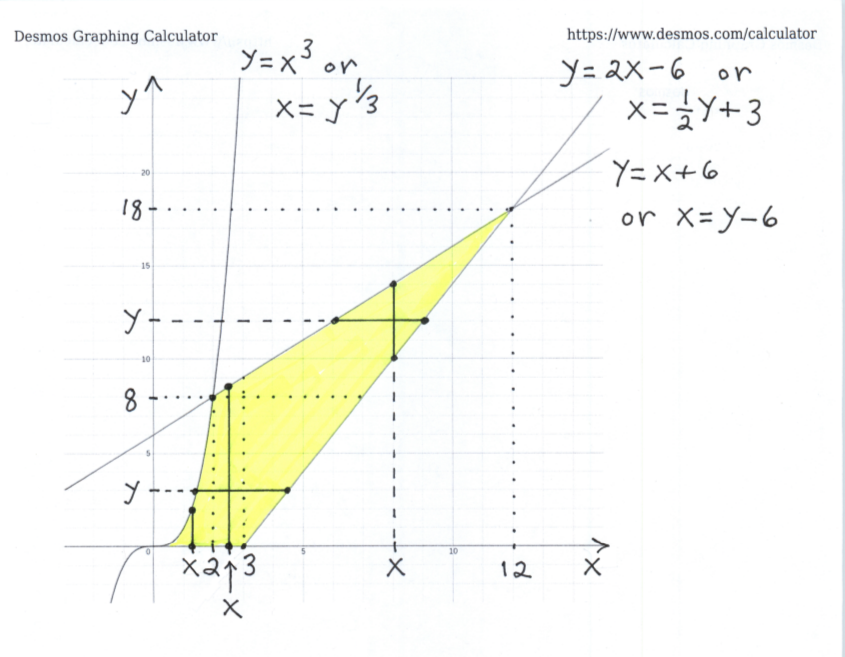SOLUTION 28: Compute the area of the region enclosed by the graphs of the equations $ y= x^3 \ \ (or \ \ x=y^{1/3})$,
$ y= x+6 \ \ (or \ \ x= y-6) $, $ y= 2x-6 \ \ (or \ \ \displaystyle{ x= \frac{1}{2}y+3 } ) $, and $y=0$ . Begin by finding the points of intersection of the the four graphs. From $ y= x^3 $ and $ y= 0 $ we get that
$$ x^3 = 0 \ \ \longrightarrow \ \ x=0 $$
From $ y=x^3 $ and $ y=x+6 $ we get that
$$ x^3 = x+6 \ \ \longrightarrow \ \ x=2 $$
From $ y= x+6 $ and $ y=2x-6 $ we get that
$$ x+6 = 2x-6 \ \ \longrightarrow \ \ x=12 $$
From $ y= 2x-6 $ and $ y=0 $ we get that
$$ 2x-6=0 \ \ \longrightarrow $$
$$ 2x=6 \ \ \longrightarrow \ \ x=3 $$
Now see the given graph of the enclosed region.

a.) Using vertical cross-sections to describe this region, which is made up of three smaller regions, we get that
$$ 0 \le x \le 2 \ \ and \ \ 0 \le y \le x^3 \ $$
in addition to
$$ 2 \le x \le 3 \ \ and \ \ 0 \le y \le x+6 \ , $$
and
$$ 3 \le x \le 12 \ \ and \ \ 2x-6 \le y \le x+6 \ , $$
so that the area of this region is
$$ AREA = \displaystyle{ \int_{0}^{2} \Big( Top \ - Bottom \ \Big) \ dx + \int_{2}^{3} \Big( Top \ - \ Bottom \Big) \ dx
+ \int_{3}^{12} \Big( Top \ - Bottom \ \Big) \ dx } $$
$$ = \displaystyle{ \int_{0}^{2} \Big( x^3 - 0 \Big) \ dx + \int_{2}^{3} \Big( (x+6) - 0 \Big) \ dx
+ \int_{3}^{12} \Big( (x+6) - (2x-6) \Big) \ dx } $$
$$ = \displaystyle{ \int_{0}^{2} x^3 \ dx + \int_{2}^{3} ( x+6 ) \ dx
+ \int_{3}^{12} ( 12-x) ) \ dx } $$
$$ \displaystyle { = \Big( \frac{x^4}{4} \Big) \Big\vert_{0}^{2} + \Big( \frac{x^2}{2} + 6x \Big) \Big\vert_{2}^{3}
+ \Big( 12x- \frac{x^2}{2} \Big) \Big\vert_{3}^{12} } $$
$$ \displaystyle { = \Big( \frac{(2)^4}{4} - \frac{(0)^4}{4} \Big)
+ \Big( \Big( \frac{(3)^2}{2} + 6(3) \Big) - \Big( \frac{(2)^2}{2} + 6(2) \Big) \Big)
+ \Big( \Big( 12(12)-\frac{(12)^2}{2} \Big) - \Big( 12(3)- \frac{(3)^2}{2} \Big) \Big) } $$
$$ \displaystyle { = \Big(4 \Big) + \Big( \frac{9}{2} + 18\Big) - \Big( 14 \Big) + \Big(72 \Big) - \Big( 36- \frac{9}{2} \Big) } $$
$$ \displaystyle { = 53 } $$
b.) Using horizontal cross-sections to describe this region, which is made up of two smaller regions, we get that
$$ 0 \le y \le 8 \ \ and \ \ y^{1/3} \le x \le \displaystyle{ \frac{1}{2}y+3 } \ , $$
in addition to
$$ 8 \le y \le 18 \ \ and \ \ y-6 \le x \le \displaystyle{ \frac{1}{2}y+3 } \ , $$
so that the area of this region is
$$ AREA = \displaystyle{ \int_{0}^{8} ( Right \ - \ Left ) \ dy + \int_{8}^{18} ( Right \ - \ Left ) \ dy } $$
$$ = \displaystyle{ \int_{0}^{8} \Big( \Big( \frac{1}{2}y+3 \Big) - \Big( y^{1/3} \Big) \Big) \ dy
+ \int_{8}^{18} \Big( \Big( \frac{1}{2}y+3 \Big) - \Big( y-6 \Big) \Big) \ dy } $$
$$ = \displaystyle{ \int_{0}^{8} \Big( \frac{1}{2}y+3 - y^{1/3} \Big) \ dy
+ \int_{8}^{18} \Big( 9 - \frac{1}{2}y \Big) \ dy } $$
$$ \displaystyle{ = \Big( \frac{y^2}{4} + 3y - \frac{3}{4}y^{4/3} \Big) \Big\vert_{0}^{8}
+ \Big( 9y - \frac{y^2}{4} \Big) \Big\vert_{8}^{18} } $$
$$ \displaystyle{ = \Big( \Big( \frac{(8)^2}{4} + 3(8) - \frac{3}{4}(8)^{4/3} \Big)
- \Big( \frac{(0)^2}{4} + 3(0) - \frac{3}{4}(0)^{4/3} \Big) \Big)
+ \Big( \Big( 9(18) - \frac{(18)^2}{4} \Big) - \Big( 9(8) - \frac{(8)^2}{4} \Big) \Big) } $$
$$ = \Big(28 \Big) - \Big(0 \Big) + \Big(81 \Big) - \Big(56 \Big) $$
$$ = 53 $$
Click HERE to return to the list of problems.

